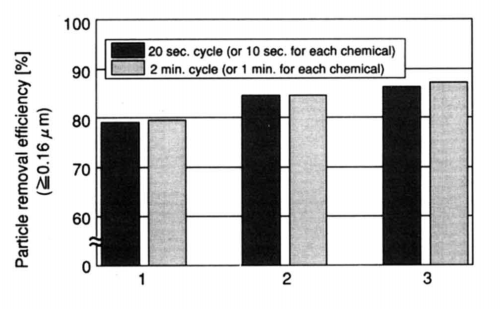We have developed a new technique of single-wafer spin cleaning at room temperature, while alternately supplying ozonized water and dilute HF f or only 10 s each onto a rotating silicon wafer through jet nozzles, then repeating the cycle until the surface cleanliness reaches the required level. The new spin cleaning sequence can efficiently remove both particulate and metallic contaminants as well as organic contaminants on the surface of silicon wafers in a short time with- out increasing the microroughness of the surface. This technique will meet the requirements for stricter wafer cleanliness, larger diameter wafer processing, and greater respect for the environment.
Wet chemical processing is the most repetitively applied processing step in any large fabrication sequence. Wafer cleaning chemistry has remained essentially unchanged over the past 25 years,1 the most prevalent method in the semiconductor industry worldwide still being the hydrogen peroxide-based wet chemical process, most notably the RCA standard cleans,2 in which wafers are sequentially immersed for minutes in chemicals such as a NH4OH/ H202/H20 mixture and a HC1/H202/H20 mixture at elevated temperatures, as well as in dilute HF (DHF) at room temperature. In some cases, a hot H2S04/11102 mixture is added at the beginning of the sequence.
In such immersion-type wet chemical cleaning, even if ultrapure chemicals are introduced and then disposed of after each wafer cleaning treatment, the contamination removal efficiency is dominated by the amount of impurities brought into the fresh solution by the to-be-cleaned wafers themselves.34 In order to meet stricter wafer cleanliness requirements in the future, new cleaning methods, in which fresh chemicals are continuously supplied, such as single-wafer spin cleaning, will have to be employed. The spin-processing equipment has the advantage of a much smaller footprint than that of the conventional wet bench, but its throughput must be increased and its chemical consumption reduced.1 To do so, a technique using alternative cost-effective chemicals rather than the conventional RCA standard cleans, as well using a fewer number of chemicals, must be employed to shorten the cleaning period as well as to reduce chemical consumption and consequently to reduce the amount of effluents generated by the cleaning.

Fig1
The concentration of ozone in DI water was kept at20 ppm throughout this study, and was measured at theoutlet of the ozonized water generator. The HF concentra-tion in the DHF was kept at 1%. The temperature of theozonized water and DHF solution was kept at 23°C (roomtemperature) throughout the experiment. The rotatingspeed of the wafer in the spin cleaning system was kept at1600 rpm.Fresh ozonized water and DHF were supplied tothe center area of the wafer surface continuously at a rateof 20 and 25 cm'/s, respectively. The flow rate of DI waterfor a final rinse was kept at 25 cm'/s.The ozonized waterand DHF as well as DI water were disposed of after beingutilized on the wafer.
上一篇: 使用 TMAH 溶液垂直蚀刻氮化铝钪薄膜
下一篇: MEMS刻蚀